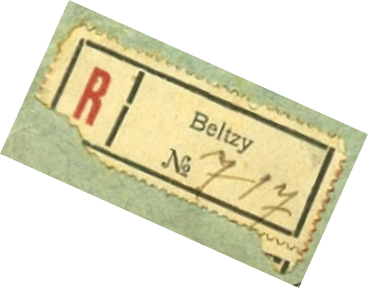
Copyright © 2017 Martin Davis

Bălţi, Moldova
Municipal Coat of Arms
Coordinates
47°46' N, 27°56' E
Alternate Names
Bălți (Moldovan
pronunciation: [ˈbəlt͡sʲ]),
Yiddish: ץלעב [Belz],
Polish: Bielce,
Russian: Бельцы,
[Byel’tsy] and Бэлць,
[Bėlts’],
Ukrainian: Бєльці,
[Bel’tsi].

This page is hosted at no cost to the public by JewishGen, Inc., a non-profit corporation. If you feel there is a
benefit to you in accessing this site, your JewishGen-erosity is appreciated.
http://www.jewishgen.org/JewishGen-erosity/

An Introduction
Bălţi (Belz) is the second-largest city of the Republic of Moldova and the main city of the northern region and today has a population of over 140,000 people. The town is situated on the small river Răut (known to its former Jewish inhabitants as the Revet), a tributary of the Nistru Dniester, located within a a hilly landscape; which in the Middle Ages was covered with forest. The town and the region has had a turbulent history and this has had (and continues to have) a profound effect on the various communities that formed its population. According to the Romanian official census for 1930, Bălţi had a population of 30,570, comprising 14,200 Jews, 8,900 Romanians, 5,400 Russians and Ukrainians, and 1,000 Poles. 14,400 of the inhabitants were Christian Orthodox, 14,250 Jewish, and 1,250 Roman Catholic. In that year, the city represented only 7.9% of the population of the surrounding Bălţi County (so the town functioned as an urban centre for a mainly rural population). Today the municipality covers an area of 78.0 sq km, of which the city constitutes 41.42 sq km, the village Elisabeta (an eastern suburb) 9.81 sq km, and the village Sadovoe (a north-western suburb) 26.77 sq km. Of these, an important portion (20.11 km) is actually agricultural land. Some city neighbourhoods bear the names of the former 19th century suburbs: Pamanteni, Slobozia, Molodova, Baltul Nou, Podul. This KehilaLinks site is intended to give an outline impression of the vibrant Jewish communal life of Bălţi before the onset of the Second World War. A war and subsequent history which has seen the Jewish community reduced by over 95% to today’s population of approximately 400. The Story of the Jewish Community of Bălţi is written of in detail on the Yad Vashem site of the same name, which is a source of invaluable information about the general history of the town and the impact of the Shoah on the community of Bălţi. This KehilaLinks site is not intended to do anything other than add to the sum total of information about the former Jewish community of Bălţi and to further memorialise its way of life.



Strada Regele (King) Ferdinand, Bălţi circa 1890


















